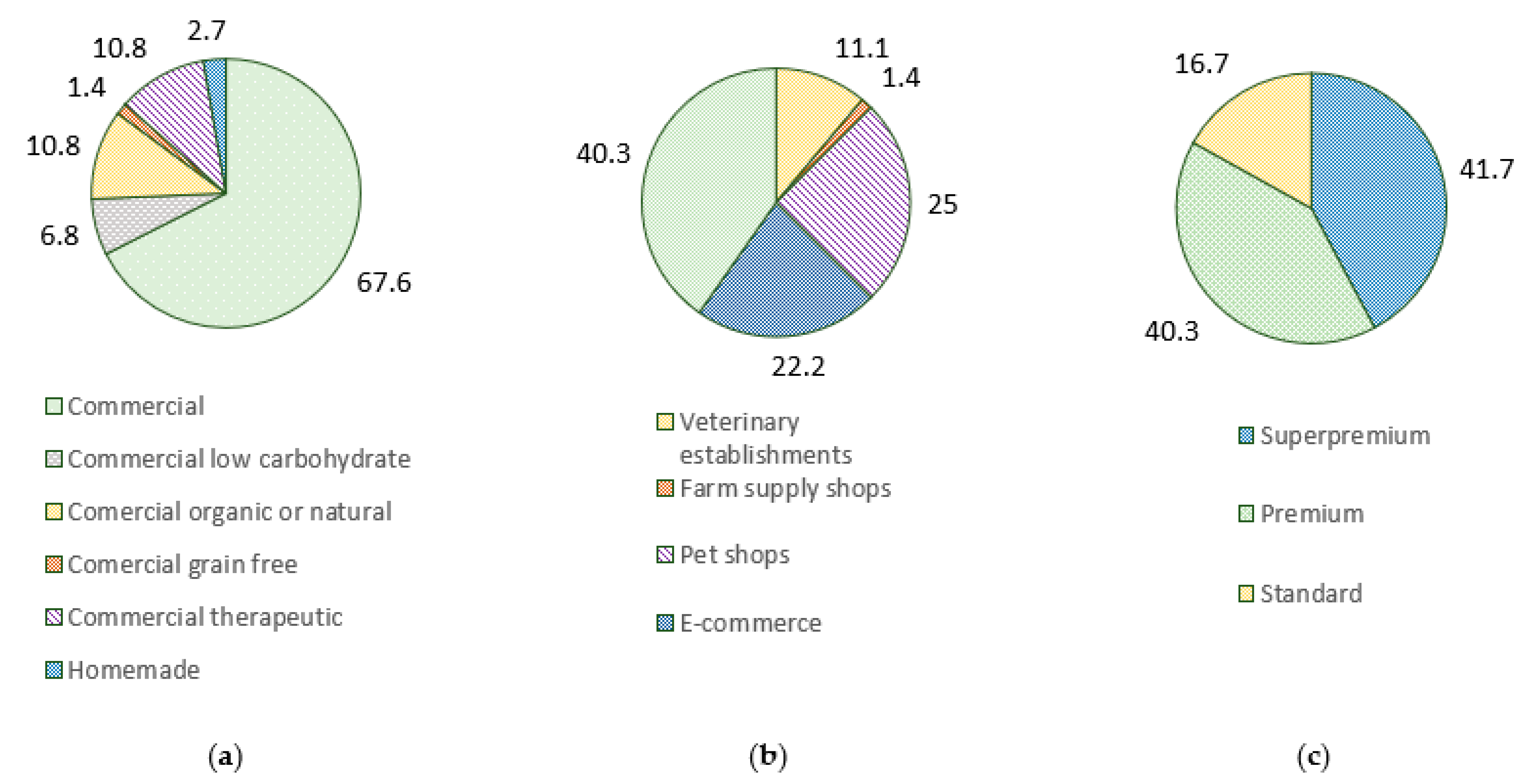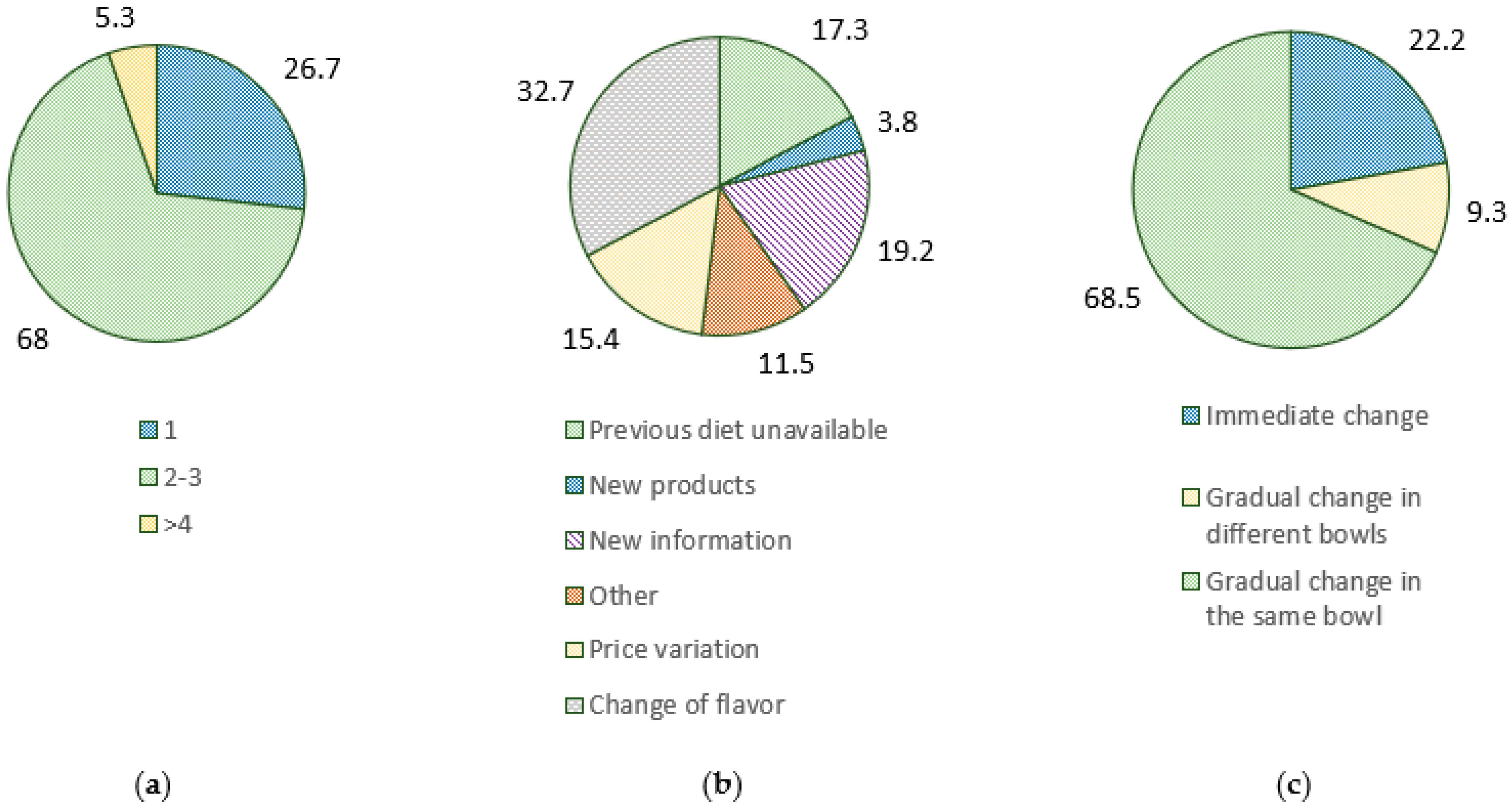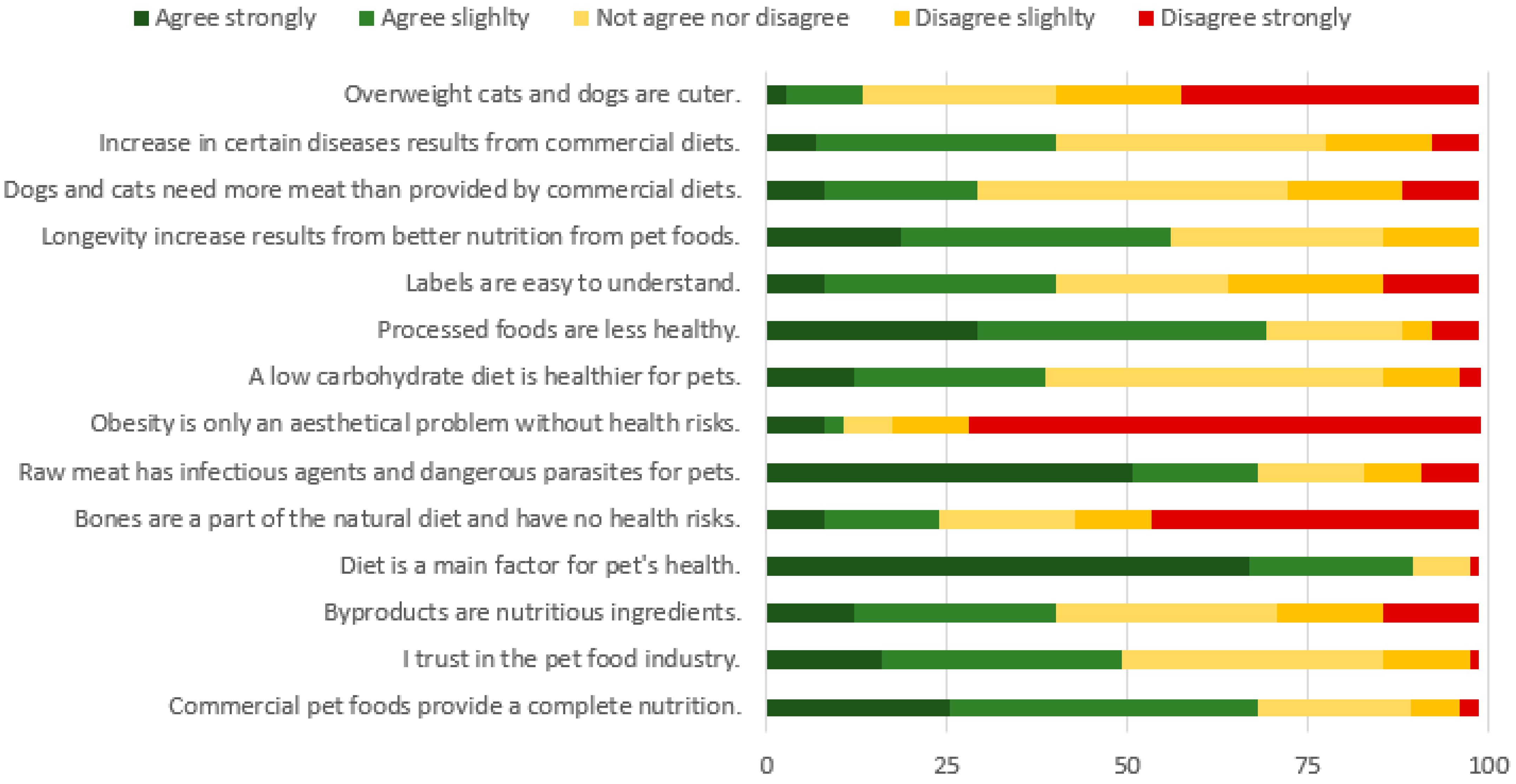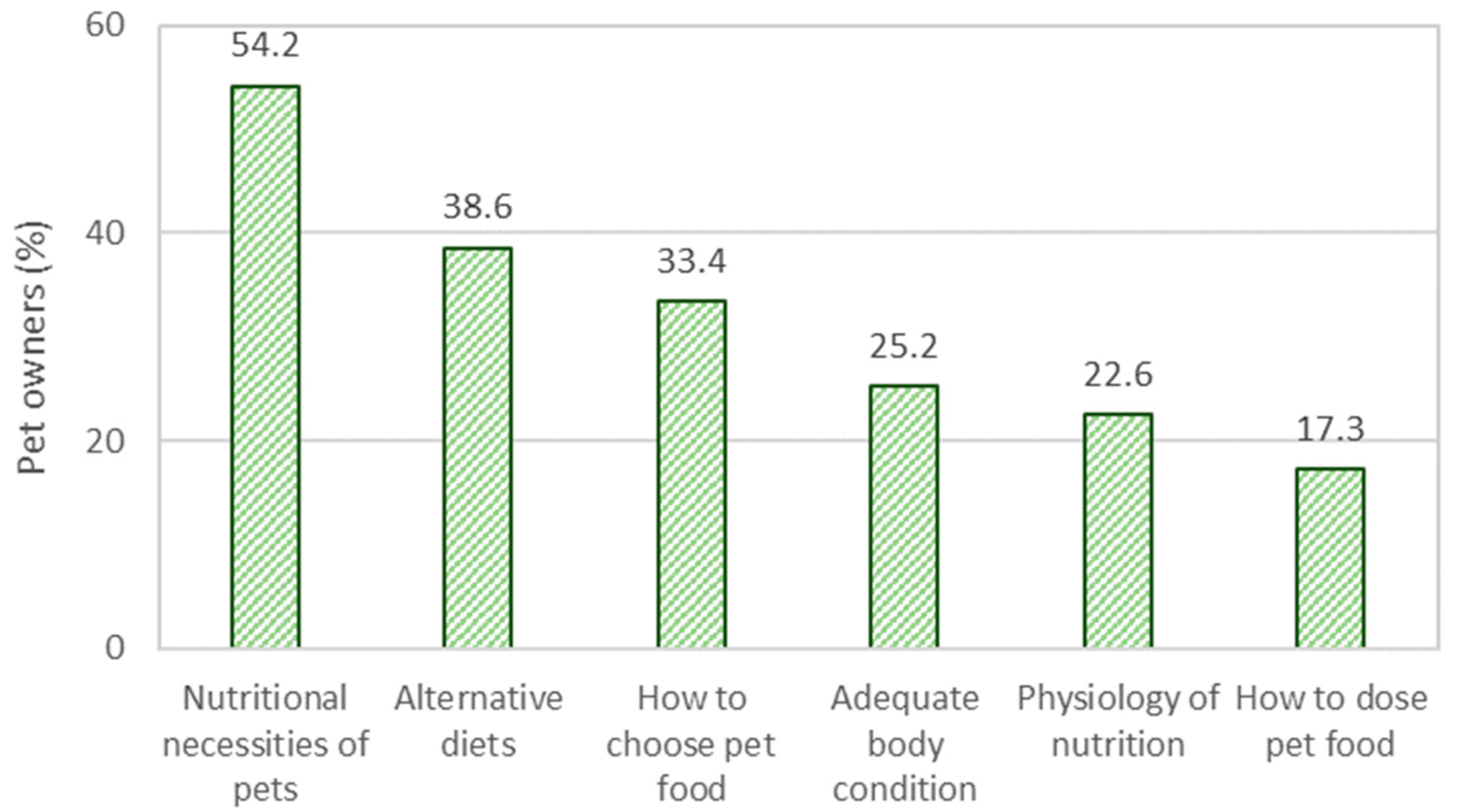Survey of Pet Owner Attitudes on Diet Choices and Feeding Practices for Their Pets in Portugal
Abstract
Simple Summary
Abstract
1. Introduction
2. Materials and Methods
3. Results
3.1. Characteristics of the Participants and Companion Animals
3.2. Diet Choices of Portuguese Owners
3.3. Feeding Habits of Portuguese Owners
3.4. Exercise, Affective Feeding, and Body Condition Score
3.5. Reasons for Pet Food Choices and Sources of Information on Healthy Pet Diet
3.6. Pet Owners’ Opinions on Pet Food
3.7. Information Needs of Pet Owners Regarding Pet Diets
4. Discussion
4.1. Demographics and Pet Food Types
4.2. Feeding Habits, Exercise, and Body Condition Score
4.3. Factors Influencing Pet Food Purchasing Decision
4.4. Perceptions and Information Needs
5. Conclusions and Recommendations
Funding
Institutional Review Board Statement
Informed Consent Statement
Data Availability Statement
Acknowledgments
Conflicts of Interest
Appendix A
| Category | Question | Response |
|---|---|---|
| Demographic data | I agree with the participation in the study and anonymous collection of data (Consent form). | Yes/No |
| Name | Open question | |
| Sex | Male/Female | |
| Region | North, Center, Lisbon, Alentejo, Algarve, Madeira, Açores | |
| Age | Open question | |
| What companion animals do you have? | Dog, Cat, Others | |
| How many dogs do you own? | Open question | |
| How many cats do you own? | Open question | |
| Pet food choices and habits | What type of diet do you feed your pet? | Commercial, Commercial low carbohydrate, Commercial organic or natural, Commercial grain free, Commercial therapeutical, Homemade |
| Why do you choose to use this type of pet food? | Open question | |
| Where do you obtain information to choose the companion animal’s diet? | Veterinarian, Pet shops, Friends and family, Other pet owners (in person), Online (websites, social media, forums) | |
| Have you talked about your pet’s diet with your veterinarian? | Yes/No | |
| Do you intend to talk about your pet’s diet with your veterinarian in the future? | Yes/No | |
| What do you think is most important when choosing the diet of your companion animal? | Brand, Price, Flavor, Ingredients, Nutritional table, Metabolism and age, Laboratory validation, I do not buy | |
| Where do you buy pet food? | Veterinarian, Farm supply stores, Pet shops, E-commerce, Supermarkets, I do not buy | |
| What type of pet food do you usually buy? | Standard (low range), Premium (middle range), Super-premium (high range), I do not buy | |
| Do you usually switch pet foods (at each 3 months or less)? | Yes, No, I do not buy | |
| What is the factor leading you to switching pet foods? | Previous diet unavailable, New products, New information, Price variations, Change of flavor, Others, I do not buy | |
| How do you usually conduct a change of pet foods? | Immediate change, Gradual change in a different bowl, Gradual change in the same bowl, I do not buy | |
| In average, how much do you spend each month feeding your pet (€)? | Open question | |
| Based on the picture presented above, what do you think is the ideal body condition score for a cat or dog? | 1, 2, 3, 4, 5 | |
| Do you feel that feeding is important to reinforce the affective connection with your pet? | Yes/No | |
| Pet feeding habits | Do you usually feed treats or snacks for cats or dogs? | Yes/No |
| Do you usually feed foods for human consumption (e.g., from your plate, food scraps, etc)? | Yes/No | |
| How do you feed your pet? | Fill the bowl, Dosing according to the label, I do not use | |
| How many times per day do you feed your pet? | 1, 2–3, 4–5, >5 | |
| Do you use toys which release foods? | Yes/No | |
| Do you use food bowls with puzzles or labyrinths which reduce the food ingestion velocity? | Yes/No | |
| Based on the picture above, what is the body condition score of you dog or cat? | 1, 2, 3, 4, 5 | |
| How long do you spend each day playing or walking your pet? | <15 min, 15–30 min, 30–60 min, 1–2 h, >2 h | |
| Pet owner’s opinions | Commercial pet foods provide a complete nutrition. | Classify the sentences according to your degree of agreement:
|
| I trust in the pet food industry. | ||
| Byproducts are nutritious ingredients. | ||
| Diet is a main factor for pet’s health. | ||
| Bones are a part of the natural diet and have no health risks. | ||
| Raw meat has infectious agents and dangerous parasites for pets. | ||
| Obesity is only an aesthetical problem without health risks. | ||
| A low carbohydrate diet is healthier for pets. | ||
| Processed foods are less healthy. | ||
| Labels are easy to understand. | ||
| Longevity increase results from better nutrition from pet foods. | ||
| Dogs and cats need more meat than provided by commercial diets | ||
| Increase in certain diseases results from commercial diets. | ||
| Overweight cats and dogs are cuter. | ||
| What topics related to pet foods and feeding would you like to know more about? | Nutritional necessities of pets, Alternative diets, How to choose pet foods, Adequate body condition, Physiology of nutrition, How to dose pet food |
| Consent Form | Responses |
|---|---|
| You are invited to participate in a research study about pet food diets and practices in Portuguese pet owners. Participants should be over 18 years old. Participation in this study is voluntary and respondents can leave the page at any moment without personal prejudice. The survey takes 25 min to complete and is mainly comprised of multiple-choice and checkboxes, while participants may optionally also write open responses. While the study may not benefit you directly, it will provide essential information on the husbandry and feeding practices in Portugal, which provides essential information to improve pet care at national level. All collected data is confidential and anonymous. Data collected will not be used for commercial purposes, marketing campaigns, or provided to third parties. Data collected in the survey will be solely used for statistical and scientific purposes. Data will be stored safely and only accessed by the investigator for the purposes stated above. By accepting the consent form, I agree with the use of data for non-commercial use. | I agree with the participation in the survey and anonymous collection of data. |
| I do not agree. |
Appendix B
| Main Factor in Diet Choice | Main Source of Information | |||
|---|---|---|---|---|
| Ingredients | Not Ingredients | Online | Not Online | |
| Commercial diet | 47.8 | 76.5 | 83.3 | 64.5 |
| Home made | 4.3 | 2.0 | 0.0 | 3.2 |
| Commercial low carbohydrates | 8.7 | 5.9 | 8.3 | 6.5 |
| Commercial organic or natural | 26.1 | 3.9 | 8.3 | 11.3 |
| Commercial grain free | 0.0 | 2.0 | 0.0 | 1.6 |
| Commercial therapeutical | 13.0 | 9.8 | 0.0 | 12.9 |
| N | 23 | 51 | 12 | 62 |
| Pet Food Type | ||||||||
|---|---|---|---|---|---|---|---|---|
| Total | Commercial | Alternative | Therapeutical | |||||
| Mean ± SD | Median | Mean ± SD | Median | Mean ± SD | Median | Mean ± SD | Median | |
| Commercial pet foods provide a complete nutrition. | 2.2 ± 1.0 | 2.0 | 2.1 ± 0.9 | 2.0 | 2.4 ± 1.1 | 2.5 | 2.4 ± 1.1 | 2.5 |
| I trust in the pet food industry. | 2.5 ± 1.0 | 2.5 | 2.4 ± 0.8 | 2.0 | 2.6 ± 1.1 | 3.0 | 2.5 ± 1.3 | 2.5 |
| Byproducts are nutritious ingredients. | 2.9 ± 1.2 | 3.0 | 2.8 ± 1.1 | 3.0 | 3.1 ± 1.3 | 3.0 | 3.0 ± 1.6 | 3.0 |
| Diet is a main factor for pet’s health. | 1.4 ± 0.8 | 1.0 | 1.5 ± 0.7 | 1.0 | 1.4 ± 1.0 | 1.0 | 1.1 ± 0.4 | 1.0 |
| Bones are a part of the natural diet and have no health risks. | 3.7 ± 1.4 | 4.0 | 3.8 ± 1.4 | 4.0 | 3.3 ± 1.4 | 3.0 | 4.1 ± 1.5 | 5.0 |
| Raw meat has infectious agents and dangerous parasites for pets. | 2.0 ± 1.3 | 1.0 | 2.1 ± 1.4 | 1.0 | 2.1 ± 1.2 | 2.0 | 1.8 ± 1.2 | 1.0 |
| Obesity is only an aesthetical problem without health risks. | 4.4 ± 1.2 | 5.0 | 4.3 ± 1.3 | 5.0 | 4.6 ± 0.8 | 5.0 | 4.0 ± 1.4 | 4.5 |
| A low carbohydrate diet is healthier for pets. | 2.6 ± 0.9 | 3.0 | 2.6 ± 0.9 | 3.0 | 2.6 ± 1.1 | 2.5 | 2.8 ± 0.9 | 3.0 |
| Processed foods are less healthy. | 2.2 ± 1.1 | 2.0 | 2.1 ± 1.0 | 2.0 | 2.1 ± 1.3 | 2.0 | 2.5 ± 1.2 | 2.5 |
| Labels are easy to understand. | 3.0 ± 1.2 | 3.0 | 3.0 ± 1.2 | 3.0 | 3.1 ± 1.3 | 3.0 | 2.5 ± 1.1 | 3.0 |
| Longevity increase results from better nutrition from pet foods. | 2.4 ± 0.9 | 2.0 | 2.4 ± 0.9 | 2.0 | 2.4 ± 0.9 | 2.0 | 2.3 ± 1.2 | 2.5 |
| Dogs and cats need more meat than provided by commercial diets | 3.0 ± 1.0 | 3.0 | 3.1 ± 1.1 | 3.0 | 2.5 ± 0.8 | 2.0 | 3.4 ± 1.3 | 3.0 |
| Increase in certain diseases results from commercial diets. | 2.8 ± 1.0 | 3.0 | 2.9 ± 1.0 | 3.0 | 2.7 ± 1.1 | 2.5 | 2.4 ± 0.7 | 2.5 |
| Overweight cats and dogs are cuter. | 3.9 ± 1.2 | 4.0 | 3.7 ± 1.2 | 4.0 | 4.0 ± 1.0 | 4.0 | 4.8 ± 0.5 | 5.0 |
| Commercial Diet | Alternative Diet | Therapeutical Diet | ||
|---|---|---|---|---|
| Use of toys releasing foods | Yes | 20 | 9 | 0 |
| No | 30 | 7 | 8 | |
| Puzzle or labyrinths for food | Yes | 4 | 5 | 0 |
| No | 46 | 11 | 8 | |
| Use of snacks and treats | Yes | 41 | 14 | 3 |
| No | 9 | 2 | 5 |
References
- GfKTrack. 2PETs Portugal é um País Pet-Friendly. Portugal Is Pet Friendly Country. Available online: https://www.gfk.com/pt/insights/press-release/portugal-e-um-pais-pet-friendly/ (accessed on 1 September 2022).
- FEDIAF European Facts & Figures 2017. Available online: http://www.fediaf.org//who-we-are/european-statistics.html (accessed on 1 September 2022).
- Prata, J.C. Strategies for the Improvement of Pet Health and Welfare in Portugal Based on a Pilot Survey on Husbandry, Opinion, and Information Needs. Animals 2020, 10, 848. [Google Scholar] [CrossRef] [PubMed]
- Vinassa, M.; Vergnano, D.; Valle, E.; Giribaldi, M.; Nery, J.; Prola, L.; Bergero, D.; Schiavone, A. Profiling Italian cat and dog owners’ perceptions of pet food quality traits. BMC Vet. Res. 2020, 16, 131. [Google Scholar] [CrossRef] [PubMed]
- Schleicher, M.; Cash, S.B.; Freeman, L.M. Determinants of pet food purchasing decisions. Can. Vet. J. 2019, 60, 644–650. [Google Scholar]
- Michel, K.E.; Willoughby, K.N.; Abood, S.K.; Fascetti, A.J.; Fleeman, L.M.; Freeman, L.M.; Laflamme, D.P.; Bauer, C.; Kemp, B.L.E.; Doren, J.R. Van Attitudes of pet owners toward pet foods and feeding management of cats and dogs. J. Am. Vet. Med. Assoc. 2008, 233, 1699–1703. [Google Scholar] [CrossRef]
- Knight, A.; Leitsberger, M. Vegetarian versus Meat-Based Diets for Companion Animals. Animals 2016, 6, 57. [Google Scholar] [CrossRef]
- Freeman, L.M.; Chandler, M.L.; Hamper, B.A.; Weeth, L.P. Current knowledge about the risks and benefits of raw meat–based diets for dogs and cats. J. Am. Vet. Med. Assoc. 2013, 243, 1549–1558. [Google Scholar] [CrossRef] [PubMed]
- Freeman, L.M.; Stern, J.A.; Fries, R.; Adin, D.B.; Rush, J.E. Diet-associated dilated cardiomyopathy in dogs: What do we know? J. Am. Vet. Med. Assoc. 2018, 253, 1390–1394. [Google Scholar] [CrossRef]
- Conway, D.M.P.; Saker, K.E. Consumer Attitude Toward the Environmental Sustainability of Grain-Free Pet Foods. Front. Vet. Sci. 2018, 5, 170. [Google Scholar] [CrossRef]
- Dodd, S.A.S.; Cave, N.J.; Adolphe, J.L.; Shoveller, A.K.; Verbrugghe, A. Plant-based (vegan) diets for pets: A survey of pet owner attitudes and feeding practices. PLoS ONE 2019, 14, e0210806. [Google Scholar] [CrossRef]
- Morelli, G.; Bastianello, S.; Catellani, P.; Ricci, R. Raw meat-based diets for dogs: Survey of owners’ motivations, attitudes and practices. BMC Vet. Res. 2019, 15, 74. [Google Scholar] [CrossRef]
- Morgan, G.; Williams, N.; Schmidt, V.; Cookson, D.; Symington, C.; Pinchbeck, G. A Dog’s Dinner: Factors affecting food choice and feeding practices for UK dog owners feeding raw meat-based or conventional cooked diets. Prev. Vet. Med. 2022, 208, 105741. [Google Scholar] [CrossRef] [PubMed]
- Delgado, M.; Bain, M.J.; Buffington, C.T. A survey of feeding practices and use of food puzzles in owners of domestic cats. J. Feline Med. Surg. 2020, 22, 193–198. [Google Scholar] [CrossRef] [PubMed]
- PORDATA População Residente. Resident Population. Available online: https://www.pordata.pt/Municipios/População+residente-359 (accessed on 26 August 2018).
- Saleh, A.; Bista, K. Examining Factors Impacting Online Survey Response Rates in Educational Research: Perceptions of Graduate Students. J. Multidiscip. Eval. 2017, 12, 63–74. [Google Scholar]
- Yetter, G.; Capaccioli, K. Differences in responses to Web and paper surveys among school professional. Behav. Res. Methods 2012, 42, 266–272. [Google Scholar] [CrossRef] [PubMed]
- Veterinários, O.; Dos M. Observatório do Mercado. Market Overview. Available online: https://www.omv.pt/ (accessed on 1 September 2022).
- Sapowicz, S.A.; Linder, D.E.; Freeman, L.M. Body Condition Scores and Evaluation of Feeding Habits of Dogs and Cats at a Low Cost Veterinary Clinic and a General Practice. Sci. World J. 2016, 2016, 1901679. [Google Scholar] [CrossRef]
- Courcier, E.A.; Thomson, R.M.; Mellor, D.J.; Yam, P.S. An epidemiological study of environmental factors associated with canine obesity. J. Small Anim. Pract. 2010, 51, 362–367. [Google Scholar] [CrossRef] [PubMed]
- Bland, I.M.; Guthrie-Jones, A.; Taylor, R.D.; Hill, J. Dog obesity: Owner attitudes and behaviour. Prev. Vet. Med. 2009, 92, 333–340. [Google Scholar] [CrossRef] [PubMed]
- Robertson, I.D. The association of exercise, diet and other factors with owner-perceived obesity in privately owned dogs from metropolitan Perth, WA. Prev. Vet. Med. 2003, 58, 75–83. [Google Scholar] [CrossRef]
- Freeman, L.; Becvarova, I.; Cave, N.; MacKay, C.; Nguyen, P.; Rama, B.; Takashima, G.; Tiffin, R.; van Beukelen, P.; Yathiraj, S. WSAVA Nutritional Assessment Guidelines. J. Feline Med. Surg. 2011, 13, 516–525. [Google Scholar] [CrossRef]
- Yam, P.S.; Naughton, G.; Butowski, C.F.; Root, A.L. Inaccurate Assessment of Canine Body Condition Score, Bodyweight, and Pet Food Labels: A Potential Cause of Inaccurate Feeding. Vet. Sci. 2017, 4, 30. [Google Scholar] [CrossRef]
- Eastland-Jones, R.C.; German, A.J.; Holden, S.L.; Biourge, V.; Pickavance, L.C. Owner misperception of canine body condition persists despite use of a body condition score chart. J. Nutr. Sci. 2014, 3, e45. [Google Scholar] [CrossRef] [PubMed]
- Herron, M.E.; Kirby-Madden, T.M.; Lord, L.K. Effects of environmental enrichment on the behavior of shelter dogs. J. Am. Vet. Med. Assoc. 2014, 244, 687–692. [Google Scholar] [CrossRef] [PubMed]
- Dantas, L.M.; Delgado, M.M.; Johnson, I.; Buffington, C.T. Food puzzles for cats: Feeding for physical and emotional wellbeing. J. Feline Med. Surg. 2016, 18, 723–732. [Google Scholar] [CrossRef] [PubMed]
- Alho, A.M.; Pontes, J.; Pomba, C. Guardians’ Knowledge and Husbandry Practices of Feline Environmental Enrichment. J. Appl. Anim. Welf. Sci. 2016, 19, 115–125. [Google Scholar] [CrossRef]
- Thompson, A. Ingredients: Where Pet Food Starts. Top. Companion Anim. Med. 2008, 23, 127–132. [Google Scholar] [CrossRef]
- The World Small Animal Veterinary Association (WSAVA) Recommendations on Selecting Pet Food. Available online: https://wsava.org/wp-content/uploads/2020/01/Selecting-the-Best-Food-for-your-Pet.pdf (accessed on 1 September 2022).
- Boya, U.O.; Dotson, M.J.; Hyatt, E.M. A comparison of dog food choice criteria across dog owner segments: An exploratory study. Int. J. Consum. Stud. 2015, 39, 74–82. [Google Scholar] [CrossRef]
- Parr, J.M.; Remillard, R.L. Handling Alternative Dietary Requests from Pet Owners. Vet. Clin. North Am. Small Anim. Pract. 2014, 44, 667–688. [Google Scholar] [CrossRef]
- Carter, R.A.; Bauer, J.E.; Kersey, J.H.; Buff, P.R. Awareness and evaluation of natural pet food products in the United States. J. Am. Vet. Med. Assoc. 2014, 245, 1241–1248. [Google Scholar] [CrossRef]
- Bischoff, K.; Rumbeiha, W.K. Pet Food Recalls and Pet Food Contaminants in Small Animals. Vet. Clin. N. Am. Small Anim. Pract. 2018, 48, 917–931. [Google Scholar] [CrossRef]
- Commission Implementing Regulation (EU) 2017/962 of 7 June 2017 Suspending the Authorisation of Ethoxyquin as a Feed Additive for All Animal Species and Categories. Available online: https://eur-lex.europa.eu/legal-content/EN/TXT/?uri=CELEX:32017R0962 (accessed on 9 October 2022).
- McConnell, A.R.; Lloyd, E.P.; Humphrey, B.T. We Are Family: Viewing Pets as Family Members Improves Wellbeing. Anthrozoos 2019, 32, 459–470. [Google Scholar] [CrossRef]
- Freeman, L.M.; Michel, K.E. Evaluation of raw food diets for dogs. J. Am. Vet. Med. Assoc. 2001, 218, 705–709. [Google Scholar] [CrossRef] [PubMed]





| Region | n | Responses (%) | Population (%) |
|---|---|---|---|
| North | 41 | 55.4 | 34.7 |
| Center | 16 | 21.6 | 21.6 |
| Lisbon | 7 | 9.5 | 27.6 |
| Alentejo | 2 | 2.7 | 6.9 |
| Algarve | 0 | 0 | 4.3 |
| Azores | 2 | 2.7 | 2.4 |
| Madeira | 6 | 8.1 | 2.5 |
Publisher’s Note: MDPI stays neutral with regard to jurisdictional claims in published maps and institutional affiliations. |
© 2022 by the author. Licensee MDPI, Basel, Switzerland. This article is an open access article distributed under the terms and conditions of the Creative Commons Attribution (CC BY) license (https://creativecommons.org/licenses/by/4.0/).
Share and Cite
Prata, J.C. Survey of Pet Owner Attitudes on Diet Choices and Feeding Practices for Their Pets in Portugal. Animals 2022, 12, 2775. https://doi.org/10.3390/ani12202775
Prata JC. Survey of Pet Owner Attitudes on Diet Choices and Feeding Practices for Their Pets in Portugal. Animals. 2022; 12(20):2775. https://doi.org/10.3390/ani12202775
Chicago/Turabian StylePrata, Joana C. 2022. "Survey of Pet Owner Attitudes on Diet Choices and Feeding Practices for Their Pets in Portugal" Animals 12, no. 20: 2775. https://doi.org/10.3390/ani12202775
APA StylePrata, J. C. (2022). Survey of Pet Owner Attitudes on Diet Choices and Feeding Practices for Their Pets in Portugal. Animals, 12(20), 2775. https://doi.org/10.3390/ani12202775






